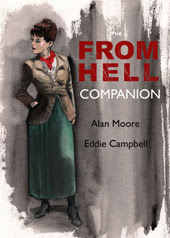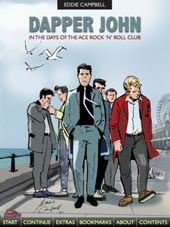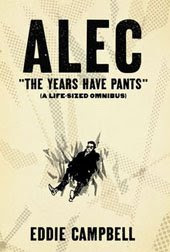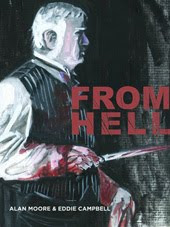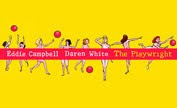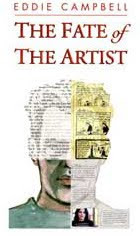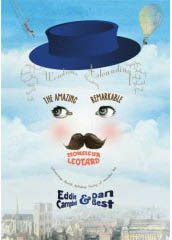While I'm waiting for my copy of Craig Thompson's Habibi to arrive from Amazon, here's a review of his
Carnet de Voyage that I wrote for the Comics Journal in 2004. In that book he did some travel research for Habibi; it's still
available from TopShelf. I've used some ready-scanned images from the internet.
 Craig Thompson
Craig Thompson
Carnet de VoyageThe travel book.I once had a memorable conversation with my fellow cartoonist Glenn Dakin (mentioned in my intro to his Abe; wrong for all the right reasons) on the subject of whether the comics medium would be the perfect vehicle, so to speak, for a 'travel book.' I don’t mean to say that we should do every kind of worthwhile type of literature into a book (hey! Nobody’s done a cookery comic!), adding notches to the lectern as we go. But the travel book we arrived at by a perfectly earnest route. To begin with, we both seemed to be getting around a great deal and were full of stories about it. And the travel book as a type has a worthy history and has always lent itself to a combination of written and pictorial jottings. On my shelf in front of me I have Eric Wharton’s Wine dark Seas (1937) illustrated by its author with some 38 ink drawings. And one of my favourite antecedents of the graphic novel is The Foreign Tour of Brown, Jones and Robinson (1856) by the great Punch cartoonist Richard Doyle. In eighty pages printed on one side only, with tissue interleaves (mimicking a watercolour sketch-book of its time?), it is a bona fide travel book (rather than a spoof of one) as well as being a great adventure narrated through drawings (with brief captions). It has all the classic situations of the travelogue: the humiliations of the customs check, the discomforts of alien toilets, the falling afoul of the local constabulary, the hint of a romantic dalliance, odd personages met on the road, astonishing scenery and archaic side-trips.
But quite apart from having a noble lineage, my reason for seeing a good prospect in the travel comic is that it offers a chance to momentarily shake the medium out of its convention-bound structural formulae. Even autobiography in literature tends to be governed by procedural templates. The memoir of a battle against alcoholism and the story of an industrialist’s success may each employ the george-and-the-dragon scenario, or the latter might opt for the david-and-goliath etc. etc. Harvey Pekar’s great achievement was to scorn the whole process of off–the-shelf scenarios in his super-ironic American Splendor. I remain unsure what to make of Our Cancer Year; his move into large scale did not result in success from this point of view. The translation into a movie oddly was a more resounding, and perhaps ultimate, victory. So my point, which I am in danger of wandering away from and having it seized by the authorities as unattended baggage, is that the travel book, since it is written on the run, offers an opportunity to avoid stock scenarios, which is not to say that it does not have a bunch to choose from. But let’s look at specifics…
 Craig Thompson.
Craig Thompson.Thompson’s Blankets was an interesting success from many angles, my favorite being that here was one of the bright young crowd merrily adapting a bunch of Eisnerian approaches into his own very individual style. Eisner’s kind of storytelling has tended to be seen in more than one decade as old-fashioned, only for a later crowd to come along and find it useful all over again. So once again we see a young artist picking up on the emotionally wrought figures, the expansive brush style, the centering of the image, letting a bit of random chiaroscuro account for the corners. Or not; it’s all loose. Thompson has a way of drawing the sexy girl that is all his own, first hand and on the spot. His set of serigraphs titled Melissa, from a French publisher, is a gorgeous, heart-melting little package in which his subject is not the girl as a figure study, or the girl as a sex object, but his total adoration of the person in front of him. We care not whether it is an undying long-term association, only that it existed and was put on paper, and perhaps that we got to see, or better, keep, one of the 333 copies of the limited edition so that we may wistfully visit her by proxy (or at least his re-creation of her, which is of course a different thing in the final analysis, though the artist may not always admit it.)
 Carnet de Voyage.
Carnet de Voyage.Craig Thompson says at the outset that this is not his ‘next book’, in spite of it being a more mature and, in my opinion, superior work of art to the earlier Goodbye Chunky Rice and Blankets. We should conclude that he, or his publisher, is being canny in heading off what might be considered the expectation of a sequel to the sentimental appeal of Blankets across America. But let me take the admonition at face value for my own purposes. We find ourselves with a dead area in the imaginary map of our art of the graphic novel. We have no common term for our informal works and ‘sketchbook’ suggests itself as a last resort. A sketchbook is where we work things out; the marginal calculations, the thought we must pin down before it evaporates, the variation to see how it looks, the spontaneous doodle, the fragmentary glimpsed detail for which we may later find a home. Crumb’s sketchbooks are the real McCoy, but Thompson’s Carnet is no more a sketchbook to my eyes than was Seth’s Vernacular Drawings, or Kochalka’s Sketchbook Diaries and I believe the integrity of the work is somewhat undermined by the designation. I would not be surprised if the market potential was also weakened. Dupuy and Berberian’s F (from the same publisher as Melissa) presented itself more confidently. It’s a gorgeous artefact. Like the Seth book it’s a series of drawings united by theme and a single vision (which is not the same thing as a single artist). When I recently declared on the TCJ message board that these two works were the best of our comics medium in the last year (2002) I elicited the response that they should be filed instead under ‘Art Books.’ In configuring the map of our art entirely around ‘sequence’ we have left no room for ‘series.’ There was a time when our medium did embrace print portfolios, such as Eisner’s City Portfolio. This approach tended toward the pretentious certainly, but no one ever suggested that it was a separate art and should be filed down the street. The medium has always had its own pop culture formats for collected images, the box of trading cards for example, such as the Sinkiewicz-illustrated Friendly Dictators set, or the book of pin-ups, such as Vertigo puts together from time to time, but we remain at a loss as to how to incorporate the phenomenon into our conceptual map.
If Thompson thought he was ‘sketching’ in Carnet then I am reminded of Monet and Renoir painting La Grenoulliere in Paris,1869, popularly regarded as the moment of the birth of Impressionism, a movement in painting whose essence was the capturing of fleeting atmospheric states while working in situ. At this stage, the evidence suggests, both men thought they were still making preparatory studies for larger, more conventional works that would subsequently be painted in the studio. But I would guess that Thompson knows Carnet is not a sketchbook because of the precise formalities he has put in place, such as its thoroughly organised lettering; its drawings cleanly presented, with reproduction the intention from the outset; its unity of instrumentation (at one point Thompson loses his brush-pen and has to temporarily switch to a cheap felt-tip; he makes a feature of the aggravation.) I suspect he also may have automatically changed the names of some parties in the work for the normal purposes of its publication as a kind of fiction. But above all, the book is written as a narrative by one who knows. Knows what? That he is a man of destiny and that his story is merely waiting for him to step into it. After 224 pages he finds a logical place to conclude it, following the resolution of an amorous encounter, though he passes it off as having simply filled his page quota. These are age-old storyteller’s tricks.

I used the expression ‘on the run’ above. Most travelogues are intended to convey the ease and relaxation that your average traveller is seeking when he ‘gets away from it all’. Thompson in fact brings it all with him. He arrives into his book burdened with the ache of an ended love, which we shall expediently associate with the subject of Blankets until he gives us another that fits the space. He arrives indeed at high speed, as though off a chute. In Carnet he has a more acute sense of his physical presence in the world than in his previous books. In fact we see it as a developing quality over the three of them. In Chunky he had a cartoon stand-in in a story of endless shy variant metaphors of real situations. In Blankets he moved up to an actor of sorts, albeit a well briefed one. Here he at last in Carnet he has the confidence to fill his own skin. He is hungry to see everything and record it, even when his hands hurt from the effort, and this is one hell of an effort, 224 pages of exact and faultless drawing in three months. He has to see a French doctor for the ache and is told that such advanced arthritis is rare in one so young. There is something in this revelation that is neither simple honesty nor unmanly complaining, but a kind of holy suffering. I think of Beethoven’s deafness before the obvious is laid before me in a drawing: Renoir in old age with his paintbrush tied to his arthritic fingers. We do not think of him as presumptuous in evoking such comparisons. He has tacitly declared himself to be our man of destiny, and we have accepted the proposition. And Renoir also filled his picture space with persons and places from Paris to Morocco.
Thompson is not a camera-bedecked ‘tourist’ and wants us to know it. In a coda at the end he informs us that he used no photographs (exceptions not worth mentioning here) to aid him in putting down his record of Paris, Morocco and all the people and stops in between. As I have oft put it: you may have seen the Eiffel Tower, but did it see you? Thompson leaves marks of his passing, often in the form of likenesses drawn and given away, (never to be seen by us) but we feel that he probably also left a lot of good feeling in his wake as he always leaves us, his readers, in good spirits.
I have long felt that all of our rules and principles for constructing comic book are all designed to keep intact the suspension of disbelief within a time-governed narrative system, like cinema in other words. It is arguable that cinema is too much of an internalised way of our natural ‘seeing’ for it to be separated from the complex of our inner eye, but I would say that as long as we describe a picture of a face as a ‘close-up’ rather than, say, a ‘portrait’ then we are a willing slave to this semantic conditioning. The travel book, as I have been envisioning it here and as Thompson has rendered it, enables us to bypass such considerations. The journalistic date headings emphasize the passage of time, but otherwise pacing and ‘timing’ are of no interest here, unless the artist sections off some little cartoon six-panel sequence in a kind of sidebar to the main progression of the work. His approaches are many and effortlessly sewn together. The immediate impression is pictorial, with the words running a helter skelter obbligato, picking up anything neglected by the image, including people’s names, which Thompson collects avidly, as though they are endangered folk melodies. And things are named and described for the sheer pleasure of it, without needing to be tied into a plot (the most tedious of all fictional constructs) and brought back at the denouement. Sometimes these words do not bother to integrate, but always they are as hand-made as the pictures, lovingly so in many instances. And what pictures! Here he stops to lavish attention on a study of a girl (often, many, different) who has posed for him, there he lingers over an expanse of rooftop detail, later a whole market stall of attention arresting oddities. But he also brings along his bag of cartoon tricks such as various alter egos who must have their say when the truth cannot be expressed otherwise. His friends are cartoonists too and where he meets them they are invited to ‘sit in’ (in the old jazz parlance) for a page. An early review described Thompson as ‘lonely’ and I had to look back to see if we were talking about the same book. The protagonist of Blankets is lonely (and autobiographical or not we must always take care to separate an author from his protagonist), a young man who has not yet found his peers. In Carnet he is a prince among his fellows. We read and we envy. We would break his goddamn fingers if we ever thought that the success of our own books could give us half as much pleasure as we get vicariously from the success of his.
 Craig Thompson's blog posts about making the book
Craig Thompson's blog posts about making the bookLabels: Craig Thompson








